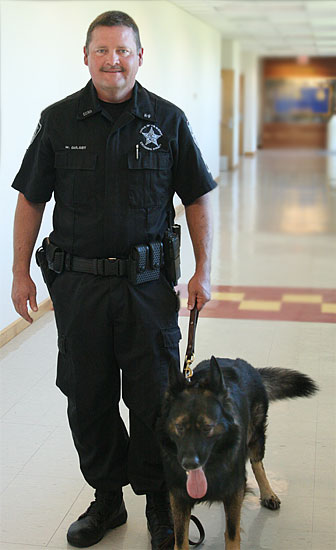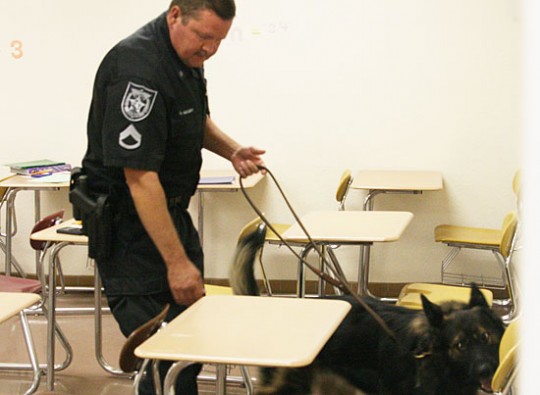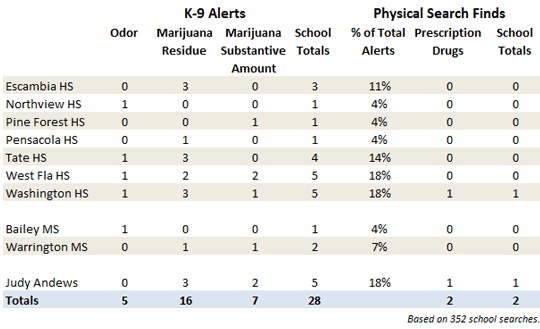Final Totals: Little Found During Daily Drug Dog Searches In Escambia County Schools
August 12, 2011
Very few drug dog searches in Escambia County’s public school resulted in any sort of drug find during a pilot program last school year.
Each school day, at least one middle or high school in the county was randomly visited by a canine officer and his dog.
During 352 school searches, there were 28 alerts. Seven of the alerts resulting in findings of drugs; the remaining 21 alerts were for residue or odor. Prescription drugs were found twice during physical searches in conjunction with the drug K-9 searches.
“These results and these tremendous decreases in the number of drug related expulsions validate the need for this comprehensive approach we have taken to curb the incidences
of illegal drugs being brought on campuses,” Jeff Bergosh, Escambia County School Board member, said Thursday evening.
Every high school had at least one alert, while only two middle schools (Bailey and Warrington) had alerts during the school year. (See a complete table at the bottom of the article.)
Findings included two grams of marijuana in a restroom at Washington High, marijuana on a bookcase and pills in a tank at the Judy Andrew Center, marijuana residue in a car at Tate High, marijuana seeds and residue in a car and a baggie of over the counter medications at Washington High and residue in a purse and marijuana in a vehicle at West Florida High.
 Among North Escambia area schools — Northview High had one drug dog alert for an odor with no drugs found, Tate High had one alert for odor and three findings of marijuana residue. There were no alerts at Ernest Ward or Ransom Middle schools.
Among North Escambia area schools — Northview High had one drug dog alert for an odor with no drugs found, Tate High had one alert for odor and three findings of marijuana residue. There were no alerts at Ernest Ward or Ransom Middle schools.
The Escambia County School Board implemented the random drug dog searches lasts school year as part of an aggressive anti-drug and alcohol policy. Only one person at the district office, Manager of Protection Services Steven Sharp, knew which school would be visited in advance. The canine officer would report to the principal’s office upon his or her arrival and was accompanied during the search by an administrator or their designee.
Students were not being searched, and they were removed from any classroom that was searched. Searches also included hallways, lockers, parking lots and other common areas.
The district spent about $36,000 from its general fund for the program. About two dozen off-duty canine officers from the Escambia County Sheriff’s Office and the Pensacola Police Department were utilized for the searches.
“The Pensacola Police Department and the Escambia County Sheriff’s Office, and their respective canine units, have been instrumental to the district’s success in our continuing work to
keep drugs out of school, and we look forward to continuing this successful partnership for many years to come,” Bergosh said.
Pictured above: Escambia County Sheriff’s Office Master Deputy Wayne Gulsby performs a drug dog search at Northview High School during the last school year. NorthEscambia.com file photos, click to enlarge. Below: Totals from all Escambia County middle and high schools.
Comments
20 Responses to “Final Totals: Little Found During Daily Drug Dog Searches In Escambia County Schools”





This is great news, but be aware, those dogs don’t smell pills. Which is what the kids are getting these days!!! Don’t be fooled.
blame the dogs
Maybe the low count of alerts indicates a poor detection rate by the dogs.
Everybody knows kids bring drugs to school…..they did wen I was goen to school n tha kids would go crazy wen they thought tha teachers er principle was on to em. I thank tha dogs was a good thangs……its better than putn a shrimp on a treadmill
REGARDING:
“what kids learned was to carry their drugs on their person as they could not be searched”
Actually, people can be searched with probable cause. A drug dog triggering on someone would give probable cause to assume the presence of drugs. If drug dogs didn’t……
David ranting
HUGE waste of tax dollars over so few finds within the school system. They’d have better luck standing outside the door at Chuck E Cheese with the drug dog.
what kids learned was to carry their drugs on their person as they could not be searched
REGARDING David Huie Green’s rant: “It’s like my elephant repellant. It seems to work because I haven’t seen any elephants. Would I have seen any if I didn’t have it? Obviously.”
What David proposes is common knowledge because there are no elephants in NorthEscambia; however, illicit drugs are everywhere and they impact all levels of the socioeconomic spectrum.
Elephant repellant would not be money well spent well here, but in some parts of Africa and Asia that might be a different story. On the other hand, drug detecting dogs might and probably do act as a deterrent for students in their decision making process.
Kudos to the school district for taking a proactive approach to an actual problem and not putting their heads in the sand and purchasing something ludicrous like elephant repellant.
They most likely had smoked it on the way to school.
You need to run for school board!
To David: Love your analytical skills!
I always thought the ones with drugs skipped school..
REGARDING:
“The drug sweeps and their relatively small number of alerts point to the fact that the canine patrols curbed the instances of students bringing drugs to school–”
He could be right but no way to prove it. It’s like my elephant repellant. It seems to work because I haven’t seen any elephants. Would I have seen any if I didn’t have it? Obviously.
Nonetheless checking but not finding does not mean a thing WOULD have happened if you didn’t check.
It’s a bit like the drug testing, assuming you must test to deal with the problem and then deciding you corrected the problem when you don’t turn up any.
David for reality
I wonder how accurate this information really is. I know a north end school had an alert in the school parking lot that resulted in problems and another alert in a bathroom that turned out to be a baggie of marijuana found. I know there were many alerts on that particular campus as well. That is just one school, how many more instances were not accuratelty accounted for with this program. It appears the real numbers are skewed with inaccurate results for some reason.
Terrific program. Now with the random drug testing this year maybe the numbers will look even better. My question is why not sniff out the kids? How many were caring on there body knowing they won’t be “sniffed out”?
amen donnie!
They might not have found much because the kids were scared to bring it to school in fear that they would be caught by the drug dogs. Great Job!! I wish there were enough resources to make the searches more often. Drugs are robbing our kids of successful lives. When they see it at home they have no fear of bringing it to school to share with their friends.
I am glad the figures were so low. I remember along the east side of Tate High’s parking lot, back in 76. The wind crying Mary.
The drug sweeps and their relatively small number of alerts point to the fact that the canine patrols curbed the instances of students bringing drugs to school–because of the random nature of the searches. This, combined with the student led awareness campaign contributed to the really huge statistic that I’m most happy about–the 43% DECREASE in the number of drug related expulsions for last school year compared to 2009-2010. I want to make it clear, William, that my enthusiasm is not about the relatively small alert rate for the canine patrols;it is about the overall impact the entire program has had on the expulsion rate–I’m quite surprised that you did not mention that. Cutting the drug related expulsion rate nearly 50% in one year is the headline, in my opinion.
I wonder just how much these 9 joints cost to find.????.tax dallars hard at work…!